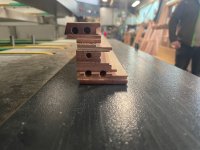I built two screen doors using 1-1/4” pine. The joinery was three, 3” x 1/2” dowels per joint.
One door is about 6 or 7 years old. The other is about 5 years old. No signs of joint failure for either.
I would guess that three dowels will be stronger than one domino and three dominoes would be stronger than three dowels. More important is that the fasteners be of a good length. I’ve seen people using really stubby dominoes and I probably would choose something longer.
I doubt that the domino would fail, but the mortise in the wood might. Greater depth would mitigate that possibility.
Screen door at the front of my house. The house is a mid-century influenced design (meaning no crown moldings anywhere). The front door has three portals to look out on. I laid it out so all three portals have no visual obstructions.
There are 10 joints on this door, so pretty strong with 3 dowels per joint.
The screen door for the rear of the garage (the older of the two doors), and a more conventional layout. Also 3 dowels per joint.
Both doors have removable screen panels. I got the rolled trim for both of the doors from Home Depot. I also got joiner corner pieces (molded plastic) that allowed me to use just square cuts. I used turn buttons to hold the panels in place.
But note, the molding is not very robust and rolling in the screens tended to make the panels bow inward. To deal with that I used 1/4” nominal plywood strips as spacers to prevent the bowing. That worked.
For the front door, I used the bronze anodized molding (also from Home Depot) but I got the hidden joiners from Amazon.com that allowed me to use mitered joints. I think it looks better, and I have my sliding table saw with dedicated 45 degree angle cuts only. Those cuts are very clean.
I had intended to use the plunger type of fasteners to hold the screens in place, but I decided that they required more effort than they were worth. (The drilling jig was going to take too long to make.)
The corner hardware and plunger hardware are from Amazon.com. If you have a miter saw that will make very clean cuts on thin aluminum, I recommend it. As I recall, my miter saw has 180 teeth and was punishingly expensive when I bought it in the 1980s.
I would note that if you are going to cut the stub tenons on your table saw, you can increase the strength of the joint by simply increasing the length of the tenon and the depth of the groove. For a screen door, I would probably use 1” long tenons.
I believe that router or shaper bits make 1/2” deep stub tenons. My instinct says that going to 1” deep tenons will double the strength of the joints, but I suspect that is not exactly correct. It will be stronger, and if you are cutting these on the table saw, no extra operations.
If you are going to have drop in screen inserts, you will have to remove most of one side of the groove. I would do that after assembly because I would end up removing the wrong side of the groove.





